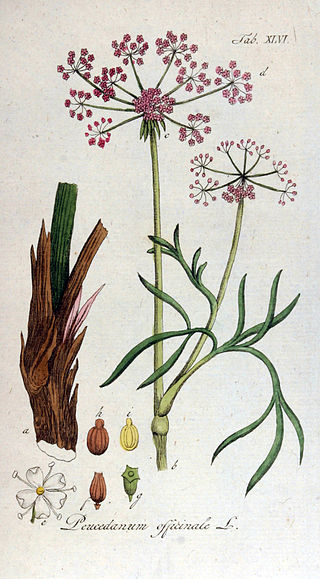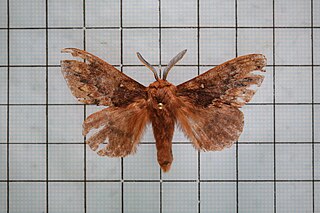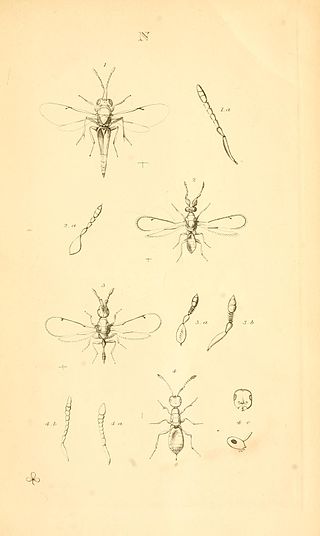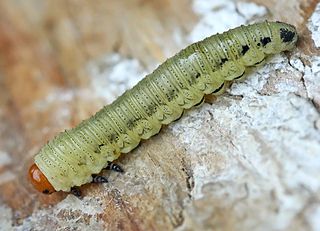
Chalcid wasps are insects within the superfamily Chalcidoidea, part of the order Hymenoptera. The superfamily contains some 22,500 known species, and an estimated total diversity of more than 500,000 species, meaning the vast majority have yet to be discovered and described. The name "chalcid" is often confused with the name "chalcidid", though the latter refers strictly to one constituent family, the Chalcididae, rather than the superfamily as a whole; accordingly, most recent publications (e.g.,) use the name "chalcidoid" when referring to members of the superfamily.

Nicolia is a genus of fossilized wood from the Late Cretaceous to Pleistocene of Belgium, Ethiopia, Egypt, New Caledonia, New Zealand, and Tunisia. The type species is N. aegyptiaca.

The Pteromalidae are a large family of wasps, the majority being parasitoids of other insects. They are found throughout the world in virtually all habitats, and many are important as biological control agents. The oldest known fossil is known from the Early Cretaceous.

Doidae is a small family of Lepidoptera with an exclusively New World distribution, with species occurring in Central America, the south-western United States, and northern South America.

Peucedanum is a genus of flowering plant in the carrot family, Apiaceae. Peucedanum boasts a global presence with diverse spread of morphological features. Peucedanum species are characterized by dorsally compressed mericarps, slightly prominent dorsal ribs, narrowly winged lateral ribs, and a broad commissure. However, the vast diversity of morphology, fruit forms, and phytochemical production makes classifying species in the Peucedanum challenging. Historically relevant in traditional medicine, Peucedanum's taxonomic complexity arises from its extensive diversity.

Karenkonia is a monotypic moth genus in the family Lasiocampidae first described by Shōnen Matsumura in 1932. Its single species, Karenkonia taiwana, described by the same author in the same year, is found in Taiwan.
Lamprantaugia is a genus of moths in the family Lasiocampidae. The genus was established by Yves de Lajonquière in 1970.
Malacostola is a genus of moths in the family Lasiocampidae. The genus was erected by Yves de Lajonquière in 1970.

Theocolax is a parasitic wasp genus in the family Cerocephalidae.

iNaturalist is an American 501(c)(3) nonprofit social network of naturalists, citizen scientists, and biologists built on the concept of mapping and sharing observations of biodiversity across the globe. iNaturalist may be accessed via its website or from its mobile applications. iNaturalist includes an automated species identification tool, and users further assist each other in identifying organisms from photographs and even sound recordings. As of 9 July 2024, iNaturalist users had contributed approximately 197,660,888 observations of plants, animals, fungi, and other organisms worldwide, and 290,007 users were active in the previous 30 days.

Apocrypta is an Old World genus of parasitic fig wasps in the family Pteromalidae. They are parasitoids of gall-wasps in the Sycophagini tribe, and especially Ceratosolen species, pollinators of the Sycomorus, Sycocarpus and Neomorphe sections of Ficus. They seem to be fig species-specific.

Cleonymus is a genus of wasps in the family Cleonymidae. There are more than 40 described species in the genus, which has been recorded on every continent except Antarctica.

Phryganea is a genus of giant caddisflies in the family Phryganeidae. Species in the genus are found throughout the northern hemisphere, of which about 13 are found in N. America.

Macroglenes is a genus of chalcidoid wasps in the family Pirenidae. There are at least 20 described species in Macroglenes.

Micropeplus is a genus of rove beetles in the family Staphylinidae. There are at least 40 described species in Micropeplus.

Diprion is a genus of conifer sawflies in the family Diprionidae. There are at least 12 described species in Diprion.

Anastatus is a large genus of parasitic wasps belonging to the family Eupelmidae.

Doddifoenus is a genus of wasps in the family Pelecinellidae. They are parasitoids of wood-boring beetles.

Aenacius is a genus of parasitic wasps in the family Encyrtidae. They are parasitoids of mealybug nymphs.
















